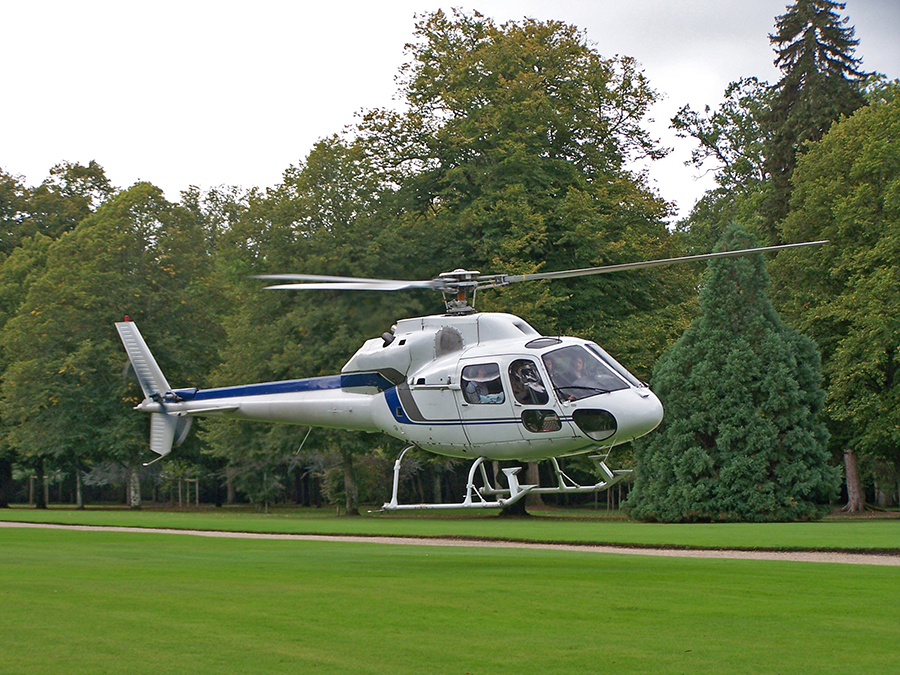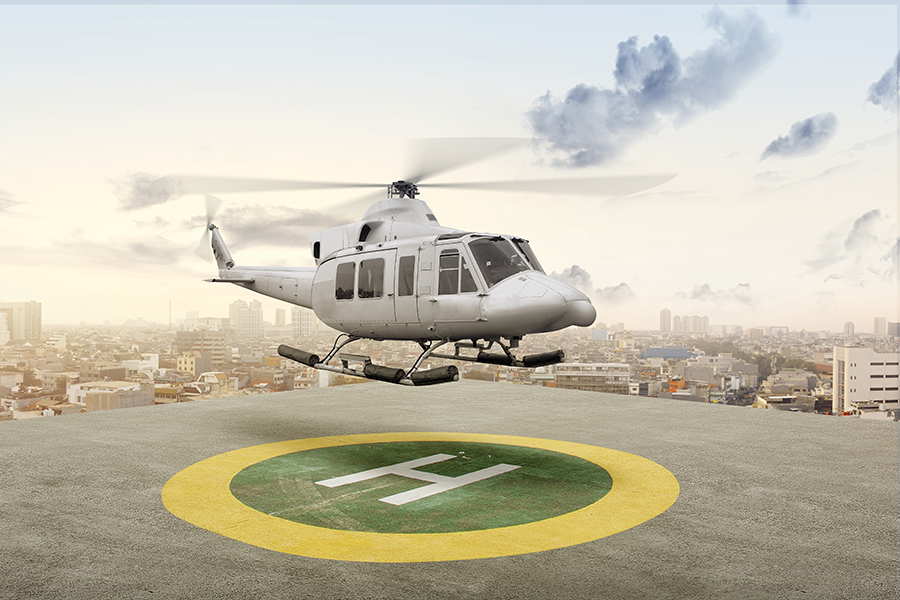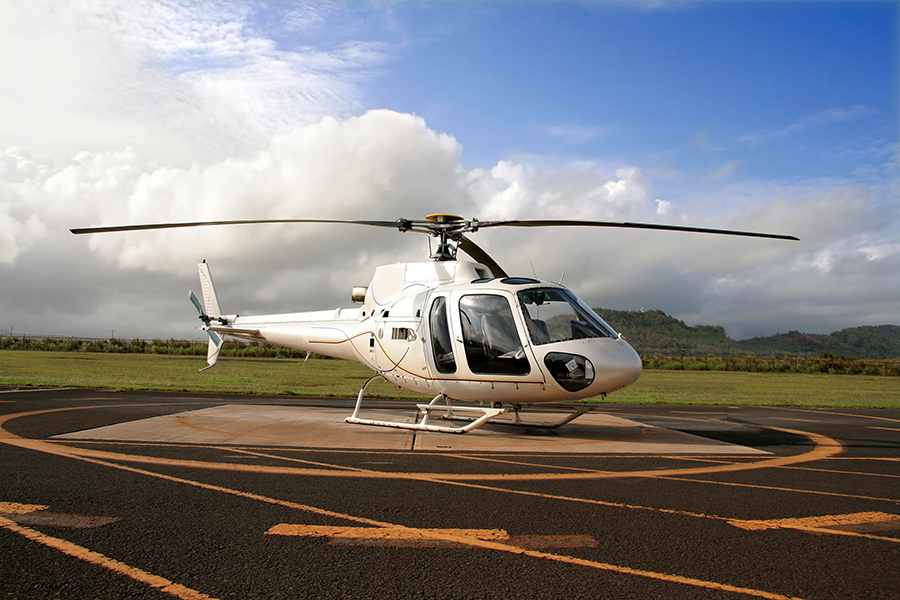When learning to fly fixed-wing aircraft, landing is one of the most difficult maneuvers for students to master, at least in the beginning. This is particularly the case with crosswind landings of course. But this is rarely the case with helicopters. Landing a helicopter is actually fairly easy, and students for the Helicopter Private Pilots’ License rarely have trouble with their landings. Having said that, helicopter landings are not always completely straightforward in every situation. There are circumstances in which performing a safe landing in a helicopter can be difficult, and there are things that can go wrong.
In this article, we will first look at the basic details of how a helicopter landing is learned and performed. We will then look at more difficult situations and some of the problems that can occur with landings.
Learning To Land a Helicopter
Helicopter take-offs and landings follow directly from hovering, and most students start to learn them as soon as they can manage to hold a steady hover. Landings are easier than take-offs for most people, so they are usually taught first.
Many students achieve their first helicopter landing without even realizing they are going to do it. This is certainly how I was taught. My instructor just told me to hover a little lower, then lower, then lower still. Finally, the helicopter touched the ground. The instructor simply pushed the collective right down, then turned to me with a pleased expression on his face and told me, “You’ve just done your first landing.” It was a good teaching method, as it got me over the student’s common fear of being close to the ground. It was also a great confidence booster. So I now teach it this way too, and I suspect most helicopter instructors do.
Whatever precise teaching technique is used in your case, to achieve a good landing you need to start with a steady hover. You need to relax, look well ahead, and hover lower and lower. It is important to make sure there is no sideways or backward movement of the helicopter before the skids make contact with the ground, or you could catch a skid and turn the helicopter over. However, a little forward movement is acceptable, and some people find this easier than trying to maintain a rock-steady hover. But whatever technique you are using, as soon as the skids touch the ground, you need to lower the collective decisively and land; you don’t want to be messing around at that point. And…that’s really about all there is to it.
Other Points Involved In Landing a Helicopter
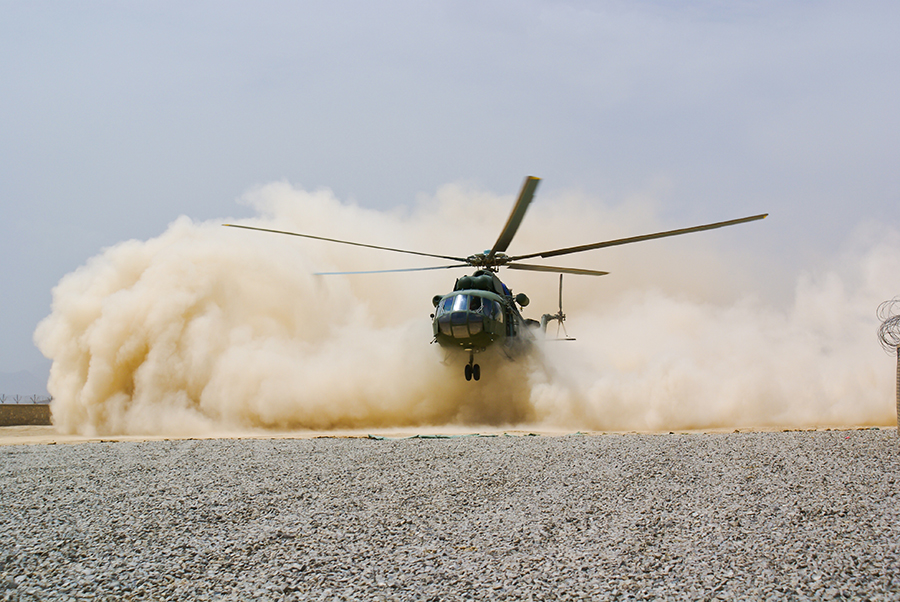
Despite the fact that helicopter landings are generally straightforward, there are a few important things to know concerning landings…
- Firstly, one skid will almost always touch the ground first, and unless you are learning on French or Russian helicopters, this is likely to be the left skid. You may or may not have realized by now that most helicopters – British and American ones anyway – hover left skid low. So this means that the left skid will touch the ground first. Don’t let that put you off, but it is a good idea to be aware of it.
- Next, as you approach the ground, you may find that your steady hover suddenly changes, and isn’t so steady anymore! You’re gradually lowering the collective, but the helicopter doesn’t seem to want to go any lower; instead, it slides and skates over an invisible barrier. You’re not going crazy; this is indeed just what is happening. The air which is drawn down through the rotors, known as the ‘induced flow’, usually dissipates, but as the helicopter gets close to the ground, the air cannot do this. Therefore the air gathers beneath the skids, and the resulting ‘ground cushion’ can literally hold the helicopter away from the ground. The strength of this ground cushion depends on the type of surface on which you are landing, and it’s much more noticeable on a hard surface than on grass. For this reason, you’ll probably learn to land on grass initially, and then have quite a shock when you come to land on asphalt or concrete. But whatever the surface, when you encounter this ‘ground effect’ simply keep going; carry on lowering the collective gently but firmly. You’ll find that dealing with the ground effect gets easier with practice.
- The final effect I need to mention is Ground Resonance. This, according to one of the well-known textbooks is “a vibration of large amplitude resulting from a deliberate or unintentional oscillation of a helicopter in contact with the ground or resting on the ground. The onset of ground resonance is recognizable by a slow rocking of the fuselage. If no remedial action is taken at an early stage, the degree of vibration may rapidly increase until the aircraft sustains major damage.” Ground resonance is known to be uncommon in the Robinson R22, and I’ve never actually encountered it in any of the other helicopters I’ve flown. It can be caused by a number of factors, but to be honest, you are fairly unlikely to have it happen. However, you do need to be aware of its possibility. If ground resonance ever does happen when you’re flying, lift off and get away from the ground if at all possible. If that can’t be done, you need to lower the collective fully, reduce power, and apply the rotor brake.
Landing a Helicopter In a Confined Area
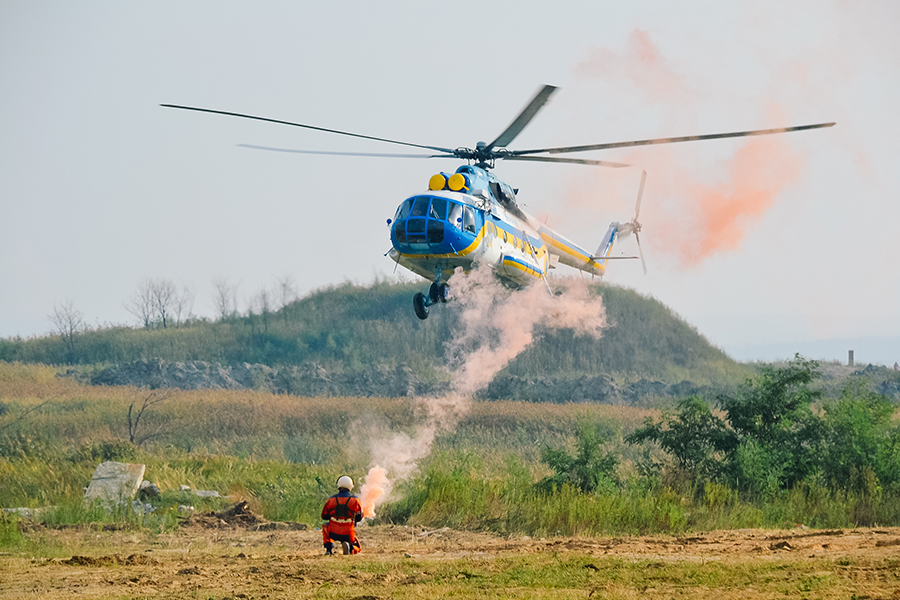
So far we have been considering landing a helicopter in ideal conditions where there is plenty of room, such as on the runway of an airfield. But we all know that helicopters can land almost anywhere; indeed, that is one of their major attractions. So you might want to land your helicopter in a field, in a friend’s garden, or even on a helipad at a hotel or restaurant where you have permission to land. Yes, you can probably do this. But then things may be somewhat more difficult.
“Helicopters can land anywhere, can’t they? You don’t need a runway or even a lot of space. You can simply fly to a point overhead of where you want to go, then come down vertically and plonk the aircraft on the ground. Easy-peasy, isn’t it?” If I had a nickel for every time I’d heard a comment similar to the above, I might not be rich, but I’d certainly be able to afford a lot more flying. And if it were the case, helicopter flying would be a whole lot easier. But it’s not quite like that in reality. It certainly isn’t ‘easy-peasy’.
It is indeed true that helicopters don’t need runways. It is also true that they can land in some fairly tight areas – small fields, back gardens, even a flat roof if you happen to live in a city and that is all that’s available. But landing in those types of situations isn’t as simple as it looks on the TV. In fact, it is really rather difficult, and for this reason, is one of the last exercises in the Helicopter Private Pilot syllabus. So let’s take a look at how you go about it.
Learning To Land In a Confined Area
Firstly, I should mention that so-called ‘confined areas’ may not actually be all that confined. Indeed, they may even be quite large, but have features that make landing a helicopter in them something of a problem. In fact, a ‘confined area’ in this context is really anywhere you plan to land a helicopter that is not on an airfield runway. You need to take the same precautions in each case. So now we will look at how you should do it.
Firstly, you need to fly a circuit at 500 feet above your proposed landing area, in order to ascertain if there are any obstacles or other problems. What sort of problems are you looking out for? Traditionally you look at the ‘five Ss’ – size, shape, surface, surrounds, and slope. In other words, is the field or other area large enough (size), is it a suitable shape (shape), are there crops or large stones in it (surface), does it have huge trees or other obstacles around it (surface), and is it reasonably flat (slope)? If you are trying to land in the countryside, you tend to add a sixth ‘S’, for sheep and other livestock, which really won’t do your helicopter any good if they start trying to eat bits! And on bright days, you add a seventh ‘S’, for the sun. As all fixed-wing pilots know, landing in a low sun can be very disorientating, and this is equally true for helicopters. However, perhaps the most important obstacles to look out for are power lines, as they are almost invisible from the air. As an instructor put it to me once, “If you can see a sticky-uppy brown thing and it doesn’t have branches or leaves, it’ll definitely have wires attached to it; so avoid it!”
After you have checked out your potential landing area, you need to work out if you can actually make a normal approach, or if you will need to do a ‘vertical let-down’, ie land the helicopter vertically. The latter isn’t as easy as most non-helicopter pilots think – it requires a great deal of power, and things can easily go wrong. And, talking of power, you always need to do a power check. The details of this vary depending on your helicopter type, but basically, you must make sure that with the conditions in that area on that day, you will not only be able to land but also get away again!
Having decided that it will be safe to land, and worked out what sort of landing you plan to perform, you need to do a ‘dummy run’. You plan and fly a circuit around your chosen landing area, performing a go-around. That way you can find out if there is anything untoward which you hadn’t thought of. And if everything looks OK, you can then try to land for real.
Possible Problems With Confined Area Landings
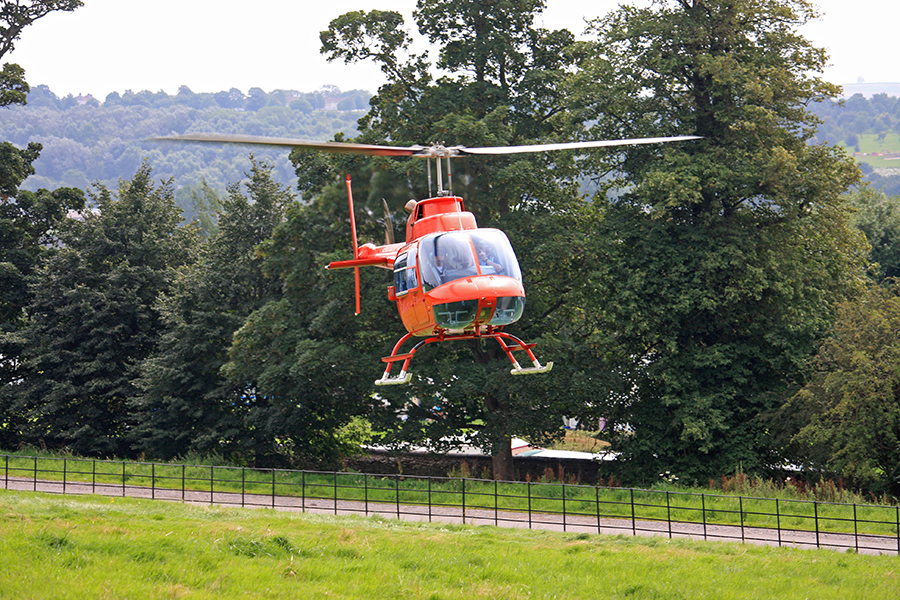
The main difficulty is that each and every confined landing area is different, so you really have to plan each one individually. This is best shown by a few examples from my own flying career, where landing looked easy but turned out not to be…
- One place where I tried to land, fairly early after I got my Private Pilot’s Helicopter License, was a friend’s field. It looked large enough, and although it was surrounded by high trees, there was plenty of space to land. The only difficulty was that he had told me there was a three-foot post sticking up from the ground, near the middle of the field. But the grass was long, and I couldn’t actually see the post from the air. This was the first indication I had that asking about a landing site in advance is always a good idea if you can do it. If not, then you need to be especially careful of long grass and what it might be hiding.
- Soon after that, I wanted to land somewhere that was rather more complicated. It was the garden of a hotel next to a large lake. It had a helipad, a large white ‘H’ marked on a small area of grass, right next to the lake. Surely if it was an ‘official’ helipad, then landing there would be easy, wouldn’t it? Not necessarily! Don’t assume that this is the case. In practice, in this instance, there were a lot of problems. It was almost impossible to land in wind, as that would take you over high ground with numerous obstacles. If you came in from any other direction, you would have to approach over the lake, and approaches over water are always difficult and not particularly safe, The only other way was to fly low over the hotel with little room for maneuver as you came into land. In fact, having checked it out carefully, I decided that landing there in those conditions was not safe, or was at any rate beyond my skill level at the time. At another time, after I had more experience, or with different wind conditions, it might have been possible.
- The third site was a farmer’s field. It looked as though there was a lot of room, but there were other issues. The farm was at the bottom of a steep-sided valley, so an approach from any direction would be difficult. And additionally, the whole area was festooned with crisscrossing power lines. The only way to land there would be to fly high over the wires, then come down vertically. It would be possible to do this, but very difficult, and even now, many years later, I don’t think it’s a landing I’d want to attempt.
A Final Important Issue – Avoiding Vortex Ring State
There is one more potential problem with helicopter landings that definitely needs to be mentioned. This is the necessity of avoiding what is called ‘Vortex Ring State’, known colloquially as the helicopter stall. So what is a vortex ring? In some parts of the world, it is referred to as ‘settling with power’; although some authorities state that the two phenomena are different. But anyway, a vortex ring state is usually defined as a condition of powered flight in which the helicopter descends into its own downwash. Under such conditions, the helicopter will fall at an extremely high rate, eventually 2,500 feet per minute or more. It will randomly yaw, pitch, and roll; there will be buffeting and juddering of the airframe, with eventually total loss of control and possible structural damage…if the aircraft hasn’t hit the ground first.
Three conditions are needed at the same time in order for Vortex Ring to occur. The helicopter must have very low airspeed, it must have power applied, and it must be descending. This usually only happens at altitude, perhaps when the pilot is distracted, or concentrating on something else, like taking aerial photos. But it can occur at a low level, particularly when making a vertical landing in a confined area. This is one reason why landings are always made moving forward if at all possible, and why confined area landings must be done with such care.
In fact, when doing the helicopter private pilot’s license course, we all learn that the most likely time for a vortex ring is the approach to landing. Instructors get used to telling their students “Forward and down”, since, with any forward airspeed, a vortex ring is unlikely if not impossible. During a normal landing, all you need to do if the aircraft starts to judder – a sign of an incipient vortex ring – is to increase the airspeed, reduce the rate of descent, or reduce the power. This is not that difficult during a normal landing. But it can be much harder in a confined area, with less room for maneuver. This is the main reason why we avoid vertical letdowns if at all possible, and always do them very slowly and carefully.
Conclusion
So as is hopefully now clear, helicopter landings are really not that difficult under most circumstances. But they do have to be undertaken with care, particularly if you are landing in a confined area, even a large one. But so long as you consider everything carefully, helicopter landings should not present a problem. Landings are certainly easier for us than they are for fixed-wing pilots.
